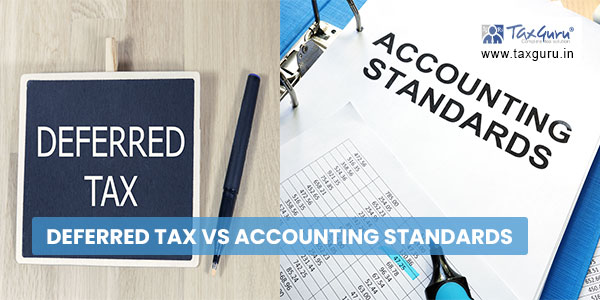Deferred Tax VS Accounting Standards
Introduction
Corporate reporting has become core business activity. GAAP, Accounting Standards, Companies Act 2013, Income Tax Act 1961 provides the guidelines for the purpose of Finalization of Annual Accounts and thereafter Reports.
In India there is no two set of books of accounts for Financial Accounts and other for Income Tax purpose.
Pre-financial Income derived by Financial Books will differ with Taxable Income. This difference in taxable liability is temporary imbalance between reported amount of Income and its taxable income. This difference in Tax deferred in the Books of accounts, according to the case, and is termed as Deferred Tax.
Page Contents
Accounting Standards for Deferred Tax
We have
1. Accounting Standard 22 (Accounting for Taxes on Income)
2. Indian Accounting Standard 12
3. International Accounting Standard 12
For disclosure requirement in financial statements and vis-à-vis that of Income and its liability.
The above Accounting Standards requires recognition of tax consequences of difference between carrying amounts of assets and liabilities and its tax bases.
The two Important Disclosures are 1) Deferred Tax Asset 2) Deferred Tax Liability.
Tax difference occur an amount of difference between the books of Accounts and Income tax Provisions.
Objectives of Ind AS 12 and as well as International Accounting Standard 12 is
1. To prescribe Accounting treatment for Income Taxes
2. to prescribe the accounting for current and future tax consequence
Indian Accounting Standard (Ind AS 37): Provisions, Contingent Liabilities and Contingent Assets, Prescribes the principles for recognition, measurement and disclosure of Provisions. It also requires to disclose certain information regarding Provisions, Contingent Liabilities and Contingent Assets in the notes to enable the users to understand their nature, timing and amount. The concept of going concern for a continued relationship with the entity is thus maintained in the Financial Reporting Statement
Where as, in Income Tax Act 1961, it considers only current years transaction for deductions in computing the taxable income of an Entity in accordance with Sec 37 of income Tax Act 1961, provides for accrual method of accounting , future loses are not allowed as deductions.
Because of above distinct concepts, There will be difference in amount calculated as the tax liability as per Financial statements and as per Income tax. These temporary differences are reported as Deferred Tax asset or Deferred Tax Liability.
Ind AS 12 or IAS 12 or AS22 requires reporting of the impact of income taxes on Income in the form of Deferred Tax Assets and Deferred tax Liabilities. This is mainly because of Time difference between reporting date and Income Tax.
Let’s now examine below, Deferred Tax Assets and Deferred Tax Liability with example.

Deferred Tax Assets
Deferred Tax Asset is income tax amount recoverable in future period in respect of deductible temporary difference, carry forward unused tax loses and carry forward unused tax credits.
Deferred Tax Asset is an item on companies Profit and Loss Account reduces the taxable income in future.
Deferred Tax assets results in excess payment of Income Tax.
Deferred Tax Asset: Example
Amount in Lakhs
| Particulars | Finance Statement of Account | Income Tax |
| Revenue as per Profit And Loss Account | 2000 | 2000 |
| Less Expenses | 1600 | |
| Expenses includes Selling & Distribution Expenses | ||
| Provision of Warranty for after sale services amounts Rs 300 Lakhs also included | ||
| Less Expense as per Income tax | ||
| ( Provision of Warranty for After sale services not allowed) Rs ( 1600-300) Lakhs | 1300 | |
| Profit | 400 | 700 |
| Tax @ 30% | 120 | 210 |
| Deferred Tax asset | 90 |
Deferred Tax Liability
Deferred Tax liability is the income tax payable in future periods with respect of taxable temporary differences.
The company will pay lower taxes in the current Period resulting in increased tax liability in future.
Deferred Tax Liability: Example
Note: company acquires Capital Asset Rs 1000000 with a life span of 5 Years
Amount in Lakhs
| Particulars | As per Finance Statement of Account | As per Income Tax |
| Profit before depreciation and Tax | 1000 | 1000 |
| Less Depreciation exp | 200 | 400 |
| PBT | 800 | 600 |
| Tax Liability-@ 30% | 240 | 180 |
| PAT | 560 | 420 |
| (Deferred Tax Liability ( Rs 240-Rs 180) Lakhs | 60
|
It is to be noted that Deferred Tax and Deferred Liabilities are created for temporary difference only. The differences will be eliminated by lapse of time.
Other items in financial statement that results in DTA/DTL are Additional Depreciation, Provision for bad and doubtful debts, unrealised receivable, employee benefits, when good are sold in instalments and etc.
Impact of Books Profit (Sec 115JB)
DTA- is credited to P/L Account- resulting in reduction in Book Profit.
DTL is debited to P/L A/c- resulting in increase of book Profit.
Conclusions
- Deferred tax Asset & Deferred Tax Liability arises due to time differences.
- We have
- Accounting Standard 22
- Indian Accounting Standard 12
- International Accounting Standard 12
For disclosure requirement in financial statements and viza a viza that of Income and its liability.
- Deferred Tax is calculated yearly by comparing Book Profit and Taxable Income.
- Inadmissible expenses as per Income Tax debited to P & L Account will Create Deferred Tax assets. Admissible expenses will result in Deferred Tax inabilities.
- The net difference of DTA/DT calculated and transferred to P & L a/c. The balance of DTA/DTL reflected in balance sheet under CA/CL respectively




